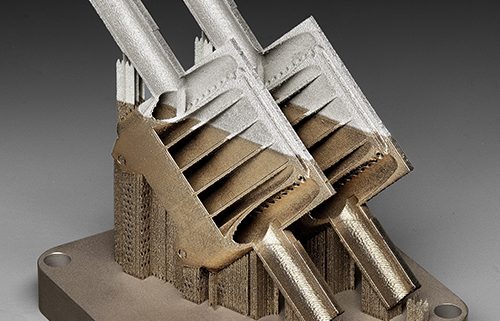As the part of the concluding stage of a multi-material additive manufacturing project, the NLR printed a demonstrator that consisted of two special metal alloys. This is an especially pertinent development, because many components and structures consist of multiple materials. Ideally, it should be possible to gradually merge these various materials together. The demonstrator was printed at the NLR’s Metal Additive Manufacturing Technology Centre (MAMTeC) in Marknesse, The Netherlands
Multi-materials
The demonstrator consists of a cutaway of an heat exchanger that is printed using stainless steel powder (SS 316) and a nickel super-alloy (Inconel 718). In the transition from Inconel 718 to SS 316, layers of the one and the other material are alternately printed. However, because the laser not only melts the powder, but also part of the underlying layers, a gradual transition from Inconel 718 to SS 316 occurs locally. The inspiration for selecting these two materials comes from the heat exchanger of NASA’s nuclear power installation for future colonies on the moon and Mars, in which SS 316 is used for reactor’s structural components and Inconel 718 for the energy conversion segment. The temperature rises in the heat exchanger, which links both systems to each other, and thus it is desirable to transition from SS 316 to Inconel 718.
Metal matrix composites
In addition to the printing of two metals through gradual transition, this multi-materials project also involves research into the printing of metal alloys with ceramic particles — the so-called metal matrix composites (MMC’s). These particles increase the rigidity, temperature resistance and abrasion resistance. The machining of these types of materials is difficult and results in substantial wear on the cutting tool. Consequently, the highly accurate printing of MMC’s offers many advantages. Within this project, research is conducted into the possibilities of printing PM1000, an extremely wear-resistant and heat-resistant nickel alloy containing yttrium oxide particles, and an aluminum alloy with silicon carbide particles. The 3D printing of MMCs is not easy. The MMC raw material behaves differently than the conventional metal powders used in 3D metallic printing, and special process parameters must be developed in order to obtain optimal material properties. A follow-up step is to develop applications of 3D printed MMCs in collaboration with interested industrial parties.
TO2 collaboration
Research into the 3D printing of diverse material combinations is conducted within the ‘Multi-Material Additive Manufacturing’ programme, in collaboration with the TO2 institutes TNO, ECN and NLR, and is financed by the Dutch Ministry of Economic Affairs.
MAMTeC
MAMTeC is the Netherlands’ premier research centre for additive manufacturing of metals. The development of Metal-AM materials and components is supported by expertise and facilities that are essential for building up advanced Metal Additive Manufacturing knowledge and skills. The quality and certification of printed components is important, particularly for aviation. It is therefore necessary to research which process parameters influence the performance of a printed component.



